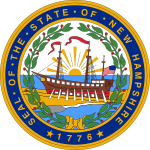
The 1948 United States Senate elections were elections which coincided with the election of Democratic President Harry S. Truman for a full term. The 32 seats of Class 2 were contested in regular elections, and one special election was held to fill a vacancy. Truman had campaigned against an "obstructionist" Congress that had blocked many of his initiatives, and in addition the U.S. economy recovered from the postwar recession of 1946–1947 by election day. Thus Truman was rewarded with a Democratic gain of nine seats in the Senate, enough to give them control of the chamber. This was the last time until 2020 that Democrats flipped a chamber of Congress in a presidential election cycle.

The 77th United States Congress was a meeting of the legislative branch of the United States federal government, composed of the United States Senate and the United States House of Representatives. It met in Washington, D.C., from January 3, 1941, to January 3, 1943, during the ninth and tenth years of Franklin D. Roosevelt's presidency. The apportionment of seats in the House of Representatives was based on the 1930 United States census.
The Silver Republican Party, later known as the Lincoln Republican Party, was a United States political party from 1896 to 1901. It was so named because it split from the Republican Party by supporting free silver and bimetallism. The main Republican Party opposed free silver and supported the gold standard. Silver Republican strength was concentrated in the Western states where silver mining was an important industry. A leading spokesman in the House of Representatives was Willis Sweet of Idaho. Silver Republicans were elected to the Congress from several Western states. In both the 1896 and 1900 presidential elections, Silver Republicans supported Democratic presidential nominee William Jennings Bryan over Republican nominee William McKinley.

The Indiana Republican Party is the affiliate of the United States Republican Party in the state of Indiana. The chairman of the Indiana Republican State Committee is Anne Hathaway.

The 1944 United States Senate election in Oklahoma took place on November 7, 1944. Incumbent Democratic Senator Elmer Thomas ran for re-election to a fourth term. Thomas once again faced a stiff challenge in the Democratic primary, this time from Congressman Wesley E. Disney and Lieutenant Governor James E. Berry. As was the case in 1938, Thomas won renomination only with a narrow plurality. In the general election, he faced former State Senator William J. Otjen, the 1942 Republican nominee for Governor. Though Thomas's performance was much reduced compared to six years prior, he still defeated Otjen by a wide margin.

The United States Senate election of 1942 in New Jersey was held on November 3, 1942. Incumbent Democratic Senator William Smathers ran for re-election to a second term, but was defeated by Republican businessman Albert Hawkes.

1959 Philadelphia's municipal election, held on November 3, involved contests for mayor, all seventeen city council seats, and several other executive and judicial offices. Citywide, the Democrats took majorities of over 200,000 votes, continuing their success from the elections four years earlier. Richardson Dilworth, who had been elected mayor in 1955, was re-elected over Republican nominee Harold Stassen. The Democrats also took fifteen of seventeen city council seats, the most seats allowed to any one party under the 1951 city charter. They further kept control of the other citywide offices. The election represented a continued consolidation of control by the Democrats after their citywide victories of the previous eight years.

The 1946 United States Senate election in Tennessee was held on November 5, 1946. Incumbent Democratic Senator Kenneth D. McKellar was re-elected to a sixth term in office. He defeated a primary challenge by Edward W. Carmack Jr. and easily won the general election against Republican William B. Ladd, and Independent candidate John Randolph Neal Jr.

The 1942 Oklahoma gubernatorial election was held on November 3, 1942, and was a race for Governor of Oklahoma. Democrat Robert S. Kerr defeated Republican William J. Otjen. Edward W. Fickinger was also on the ballot representing the Prohibition Party. Gomer Griffith Smith and Robert Burns unsuccessfully sought the Democratic nomination.

Elections were held in Illinois on Tuesday, November 2, 1976.

The 1946 Tennessee gubernatorial election was held on November 5, 1946. Incumbent Democratic Governor Jim Nance McCord defeated Republican nominee William O. Lowe with 65.4% of the vote.

The 1944 Tennessee gubernatorial election was held on November 7, 1944. Democratic nominee Jim Nance McCord defeated Republican nominee John W. Kilgo with 62.5% of the vote.

The 1942 Rhode Island gubernatorial election was held on November 3, 1942. Incumbent Democrat J. Howard McGrath defeated Republican nominee James O. McManus with 58.54% of the vote.

The 1952 New Hampshire gubernatorial election was held on November 4, 1952. Republican nominee Hugh Gregg defeated Democratic nominee William H. Craig with 63.15% of the vote.

The 1944 New Hampshire gubernatorial election was held on November 7, 1944. Republican nominee Charles M. Dale defeated Democratic nominee James J. Powers with 53.11% of the vote.

The 1940 New Hampshire gubernatorial election was held on November 5, 1940. Republican nominee Robert O. Blood defeated Democratic nominee F. Clyde Keefe with 50.74% of the vote.

The 1920 Tennessee gubernatorial election was held on November 2, 1920. Republican nominee Alfred A. Taylor, brother of former Governor Robert Love Taylor, defeated Incumbent Democratic Governor Albert H. Roberts with 54.9% of the vote.

The 1893 Ohio gubernatorial election was held on November 2, 1893. Incumbent Republican William McKinley defeated Democratic nominee Lawrence T. Neal with 51.86% of the vote.
The 1944 Massachusetts general election was held on November 7, 1944, throughout Massachusetts. Primary elections took place on July 11.
The 1942 Massachusetts general election was held on November 3, 1942, throughout Massachusetts. Primary elections took place on September 15.















